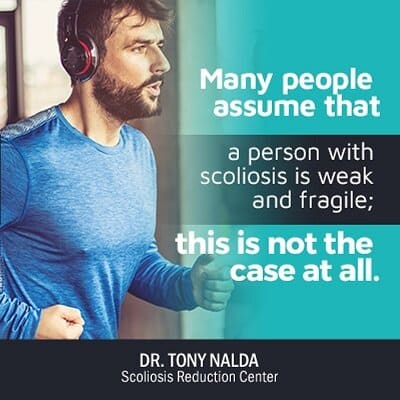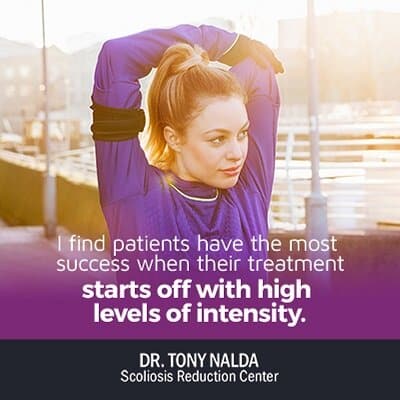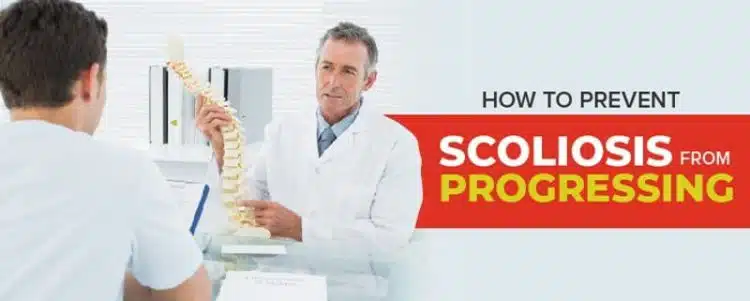As a progressive condition with no known cure, the nature of scoliosis is to worsen. If left untreated, it can progress, making it harder to treat down the road. In the majority of cases, we don’t know why scoliosis develops, but we do know how to effectively treat it by managing its progression.
Understanding Progression
A progressive condition is defined as one whose nature is to get worse over time. Some progressive conditions can be alleviated or reversed with treatment, but in many cases, people with progressive conditions live with them from the time of their diagnosis and for the rest of their lives.
When it comes to scoliosis, the condition’s rate of progression varies drastically from patient to patient. Some peoples’ scoliosis progresses at a glacial rate, while others progress rapidly.
While we can look at an X-ray and tell how much a patient has grown and how much they are likely still to grow, other than coming up with the most ‘likely’ rate of progression a patient will face, there is no definitive way to tell how much and at what rate a patient’s scoliosis is going to progress.
When treating a progressive condition, the focus becomes how to stay ahead of its progression. Treatment plans are constantly being adjusted to counteract the condition’s nature to worsen.
Forms of Scoliosis
Scoliosis is a spinal deformity marked by a sideways curvature of the spine coupled with spinal rotation. The spine of a person with scoliosis doesn’t just bend forward or backward, or to the left or to the right; it bends, curves and rotates in multiple directions as it’s a 3-dimensional condition.
Only 20 percent of diagnosed cases of scoliosis have known causes: neuromuscular scoliosis, congenital scoliosis, degenerative scoliosis, and traumatic scoliosis. As these forms of the condition are different, some being caused by secondary complications of diseases or bone malformations present at birth, progression and treatment are approached differently than with the condition’s most common form.
The vast majority of scoliosis cases, 80 percent, are classed as ‘idiopathic’, meaning they have no known single cause. The vast majority of those cases are further classed as ‘adolescent idiopathic scoliosis’ (AIS), meaning the condition develops in adolescents between the ages of 10 and 18.
In cases of AIS, it’s thought that the condition develops and progresses due to a number of factors, and those factors and how they interact can differ from patient to patient. As this form of the condition and its affected age group is by far the most common, this is where we’ll focus.
In regards to progression in adults with scoliosis, most of these cases are adolescents who went through their early years unaware they had the condition. Once those individuals reached skeletal maturity, it’s likely that pain and other scoliosis-related symptoms became more noticeable and led them to finding a diagnosis. In these types of cases, my treatment goal is to reduce their curvature to where it was before they started experiencing symptoms and pain.
Common Myths About Scoliosis
Before we start exploring how scoliosis progression is managed, I’d like to take a little time to discuss some of the many myths regarding scoliosis, particularly in regards to what living with the condition is like.
I feel it’s important to address these myths for a number of reasons: to dispel the fear that often accompanies a scoliosis diagnosis needlessly and so people can reach a greater understanding of the condition.
With a condition as mysterious as scoliosis, there is a lot of misinformation out there, so let’s take a few minutes and talk about a few of the biggest and most harmful misconceptions about the condition and its progression.
Scoliosis has Known Causes
As it was mentioned earlier, only a few forms of the condition have known causes; the remaining cases, 80 percent, aren’t caused by one single factor. I’ve heard people say that carrying a backpack on one shoulder causes scoliosis or that participating in certain sports can cause it.
The truth is that scoliosis is a symptom of an underlying condition. The curvature that develops can be likened to a fever. When a fever develops, we treat the fever to bring it down and minimize potential damage, but that’s only treating the fever as the symptom, not the cause of the fever itself.
The bottom line is that we don’t know what causes AIS to develop, but what we do know is that it’s not the result of one definite factor; instead, it’s thought to develop due to a whole host of factors that can differ from person to person.
Scoliosis is Preventable
There are people out there who think scoliosis is preventable, but that’s simply not the case. As we don’t know what causes it, we can’t come up with ways to prevent its development.
There is no specific diet or exercise plan that can keep the condition at bay. The best strategy then becomes being proactive. Be proactive enough to go for early screening or have your loved ones screened; this is the best thing you can do as early diagnosis leads to early treatment, meaning treating the condition before it’s progressed significantly.
People with Scoliosis are Weak and Fragile

Many people assume that a person with scoliosis is weak and fragile; this is not the case at all. The body is amazingly capable of adjusting to a whole host of structural changes. When a spine is curved, the body adjusts in its own way, and that adjustment doesn’t come at the expense of strength or bone density.
People with scoliosis can be just as fit and strong as the average person. In fact, I’ve treated numerous patients over the years who use their condition as additional motivation to stay strong and in shape. There’s no reason a person with scoliosis can’t live an active and full life.
Scoliosis is Very Painful to Live With
When it comes to scoliosis and pain, there’s no ‘one-fits-all’ pain level description. In AIS, pain is often a non-issue. As adolescents are constantly growing, their spine is experiencing an upward growth motion, meaning pressure on the spine and its surrounding tissues and nerves is relieved; when growth stops, however, as it does in adulthood, the curvature’s compression of the spine, tissues, and nerves can cause pain and discomfort. In adolescents, scoliosis is rarely a painful condition; in adults, it can be.
The opposite myth is also out there saying that scoliosis is never painful. Scoliosis is a condition that varies drastically from patient to patient. A condition can be classed as mild, moderate, or severe, and there’s a wide spectrum of severity and symptoms that define each patient’s experience.
Basically, scoliosis can’t be described as a particularly painful condition because of the age group it’s most prevalent in, but it also can’t be described as a painless condition because of how differently adults experience the condition.
Kids Grow Out of Their Curves Naturally
This can be a particularly dangerous misconception as it can convince parents to take a ‘watch-and-wait’ approach. The traditional watch-and-wait approach can be harmful as passively waiting can mean allowing the condition to progress unimpeded, making it harder to treat.
Only infants have the chance of outgrowing a curve, and while there are some curvatures that won’t progress past adolescence, for adolescents and adults, a crooked spine will simply not correct itself without treatment.
Progression Stops when Skeletal Maturity is Reached
Even within the medical community, the belief that scoliosis won’t progress once growth has stopped is still around. The truth is, with scoliosis, there are no guarantees, and curves can continue progressing into adulthood.
Spinal-Fusion Surgery Cures Scoliosis
This is a big one. In fact, one of the main motivating factors to writing my book Scoliosis Hope was to debunk the myth of how great spinal-fusion surgery can be for scoliosis patients.
First off, spinal-fusion surgery doesn’t cure scoliosis; as said earlier, nothing can do that. What spinal-fusion does is straighten a crooked spine, but that doesn’t happen through natural means. This is done artificially with hardware such as screws, hooks, and rods to hold the spine in place. The surgery addresses the symptom of the condition, but not the condition itself.
Also, there are no guarantees that subsequent surgeries won’t be needed should any future problems arise with the hardware, and no one can guarantee that progression won’t continue post-surgery.
There’s also the spine’s functionality to consider. Being held in position artificially is very different than actually being corrected through natural means. A spine stabilized by rods is less flexible and able to absorb shock than a spine that’s achieved a reduction through the type of scoliosis-specific chiropractic care we provide here at the Scoliosis Reduction Center®.
How to Manage Progression
When a patient comes to me for a diagnosis or to treat a pre-existing condition, the main question is, “How can we stop it from getting worse?”
First off, I make it very clear that I can neither cure their condition nor guarantee that its progression can be stopped; no one can guarantee that. What I can promise is if they fully commit to the treatment plan we customize together, they have the best possible chance of reducing their curvature, maintaining flexibility and function, and living their best lives with the condition.
The Scoliosis Reduction Center® Approach
Here at the Scoliosis Reduction Center®, we offer our patients an alternative approach to treating their scoliosis. While the traditional approach might tell them to watch and wait to see if and how much a curvature progresses, we see more harm than good in that strategy.
“Watching and waiting” means passively observing the condition while it’s left to progress unimpeded; we take the opposite approach. We value being proactive over reactive as with progressive conditions, time is valuable.
While there’s no harm in working towards achieving a reduction and establishing an effective and sustainable treatment plan before progression is evident, the harm of waiting can be much worse.
Growth is the biggest risk factor for progression, and we all know how rapid and unpredictable adolescent growth spurts can be. The danger of waiting is that in between doctor’s visits or X-rays, a growth spurt can hit and cause a condition to progress. Once that progression has occurred, it’s going to be harder to reduce.
That being said, it’s never too late to start treatment, but the sooner treatment is started, the greater the chance of successful treatment is.
What We Do and How We do It
Here at the Scoliosis Reduction Center®, we are 100-percent committed to a proactive patient-centered approach. Our approach is described as ‘functional’, meaning the goal of treatment is to reduce the curvature of the scoliosis spine while focusing on function and possibility, rather than limitation.

Our approach is to increase our patients’ balance and mobility while encouraging them to engage in and participate in their treatment. After comprehensively assessing a patient’s X-rays from a number of angles so we understand what’s happening with their spine on all 3 dimensions, we decide where we want the spine to move and how to get it there.
I find patients have the most success when their treatment starts off with high levels of intensity. In fact, 98 percent of my patients experience improvement and relief in as little as two weeks.
This is very motivating as once a patient sees those initial results, they’re willing to work even harder to sustain the results and see what else they can achieve.
Our first priority is to treat the curvature structurally.
Based on the scoliosis X-ray, we target the areas that we need to get the spine to correct in the direction and position we want it to.
Through chiropractic adjustments, the bad curve can start to correct. We monitor closely to see what types of adjustments are producing the best results.
We also come up with an exercise plan that augments those results and helps to strengthen the back muscles so they can better support the spine and maintain flexibility and mobility.
Working with our patients to design a customized scoliosis exercise plan that includes stretches puts the power in the hands of the patients as they can contribute on their own at home or anywhere they choose.
Once we’ve achieved the structural change we’re looking for, we design and incorporate an exercise plan that’s effective and sustainable. Once those aspects of treatment are established, we talk about a scoliosis-friendly diet.
Scoliosis-Friendly Diet Tips
At first thought, it may seem like diet and nutrition have little to do with the condition, but for a person with scoliosis, diet and nutrition can have a big impact on their overall health and wellness.
While no diet can make a crooked spine correct itself, a scoliosis-friendly diet can help strengthen the body and mind so it’s better able to handle the rigors of treatment and life with the condition.
Following is a list of why diet and nutrition are especially important for people living with scoliosis:
- Patients who are leaner are more responsive to treatment, not to mention it’s easier to see/feel their spine without an X-ray.
- A diet rich in amino acids (neurotransmitter precursors) addresses the link between neurotransmitter-deficiency and scoliosis development.
- Methylated B12 supplements address the connection between scoliosis patients who exhibit an inability to methylate B12 (boosts neurotransmitter production).
- Healthier patients are more compliant. As they see positive physical changes from their diet and nutritional changes, they become even more willing to work hard to see positive results.
- Diets high in calcium can improve the lower bone density that many people with scoliosis exhibit.
- Inflammation can lead to a decrease in bone density and discomfort. A diet that reduces inflammation can be very beneficial.
Scoliosis-Friendly Foods
Foods that provide the body with excellent nutrition can help it recover from scoliosis. Healthy foods can improve overall strength, energy levels, and stamina, making treatment less strenuous and more likely to succeed.
Let’s not forget the role that diet and nutrition can play in mental health; bodies that are physically healthier tend to be emotionally healthier as well. Having a mental edge can be the difference between someone who pushes through tough points in treatment or someone who gives up.
Following is a list of scoliosis-friendly foods that can help strengthen the body and the mind, and not surprisingly, these are foods with health benefits for everyone.
- Fresh fruits
- Fresh vegetables
- Lean unprocessed meats
- Foods rich in calcium and vitamin D
- Plenty of water
Following is a list of foods that aren’t part of a scoliosis-friendly diet:
- Processed meats
- Juice
- Pop
- Fast food
- Foods with corn syrup
- Sugar and sweeteners
- Alcohol
- Coffee
- White flour
- Chocolate and candy
- Salty foods
- Soy products
Conclusion
As scoliosis develops across a wide spectrum of symptoms and severity levels, no two people will experience their condition in exactly the same way. From a doctor’s perspective, that means that every patient I see needs to have a 100-percent customized treatment plan that addresses the individual characteristics of their condition.
A proactive patient-centered approach is at the heart of my practice. Here at the Scoliosis Reduction Center®, we offer patients access to multiple forms of treatment in one convenient location: rehabilitation, custom 3-D bracing, exercise and diet guidance, and scoliosis-specific chiropractic care.
While no one can tell if and how much a person’s scoliosis is going to progress, we can certainly do our best to predict how growth will affect a curvature. As we know growth is the big risk factor for progression, when treating our adolescent patients, the goal is to monitor them closely and observe how each individual patient’s growth pattern is affecting their scoliosis.
By closely monitoring and adjusting the treatment to respond to a patient’s condition, we are doing our best to manage and control its progression. While I wish there was a formula that could be applied to patients to determine how and when their condition is going to progress, that’s just not the case.
We can, however, work on strengthening the back and overall body to better withstand the challenges of the condition and treatment and minimize progression. Through scoliosis-specific chiropractic care, exercise, custom 3-D bracing, and diet guidance, we help our patients create the most favorable conditions within the body to address possible factors that could affect progression.
Here at the Scoliosis Reduction Center®, we’re trying to change the way people look at life with the condition. It doesn’t mean being weak and fragile, and it most certainly doesn’t mean living a life of limitations.





